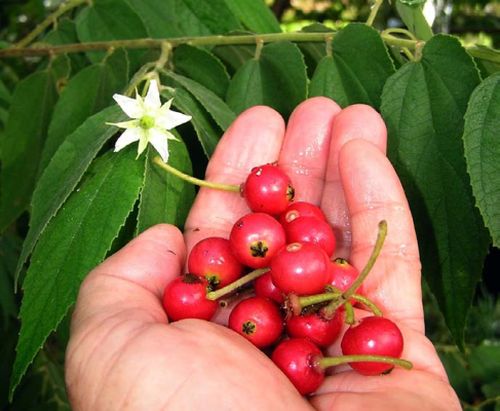Maybe the young generation is not familiar with aratilis since it is rarely seen in the urban areas nowadays. Unlike before, it was growing like mushrooms in underdeveloped areas of the metropolis. But try to ask your elder brothers or sisters or even your parents, you will get to know not only about aratilis but also their happy times when they were still young.
When asked about the aratilis trees, their common answers would be about the sweet and delicious fruits that they usually pick directly from the tree. Some children would even climb the tree or throw rocks or branches to bring the fruits down. During playtime, kids usually eat it raw. No wonder it was considered as a ready to eat food and not only by actively growing children but also by birds and fruit bats.

For the benefit of today’s generation, let us get to know more about the tree which stands witness to our elders’ sweet chilhood memories.
Muntingia calabura, commonly known as aratilis or aratiles in the Philippines, has other local names such as datiles in Bicolano and manzanitas and cereza in Ilocano. Other international names of aratilis include Jamaican Cherry, Panma Berry and Strawberry Tree in English; bolania, yamanza and memizo in Spanish; kersen in Indonesian; and trungca in Vietnamese.
Aratilis is a small tree measuring five meters to, at most, 10 meters high with spreading branches. That is why fruits are easily reached by children. Leaves are light green, oblong ovate to broadly oblong lanceolate measuring 8-13cm long and with toothed margins. White flowers are long-pedicelled, about two centimeters in diameter and solitary or in pairs. Fruits are globose, about one centimeter in diameter, smooth, light red, sweet, and with numerous tiny seeds. The tree originated in Tropical America and it was introduced during the Spanish Era in the Philippines where it was widely distributed and became thoroughly adapted.
Various uses have been found for aratilis in other parts of the world including Southeast Asia. In India, the aratilis tree is grown in urban gardens and parking lots since it is a fast growing tree and it attracts fruit-eating birds such as woodpecker. In Mexico, the aratilis fruits are usually sold in markets. In Brazil, it is planted along riverbanks to attract fish with its fruits and, as a result, the fishermen have better chances of catching the fishes. In Indonesia, where the fruits are commonly eaten raw, aratilis is not sold at all in the markets because of the abundance of the fruits specially during the fruiting season.
Aratilis fruit has 82 percent edible portion which contains (per 100g) 75.0 water, 100 kcal energy, 2.0g protein, 0.6g fat, 21.6g carbohydrates, 2.4g crude fiber, 104mg calcium, 52mg phosphorus, 0.3mg iron, 0.03mg thiamine, 0.04mg riboflavin, 0.5mg niacin, and 150mg ascorbic acid.
Common Uses and Health Benefits
Parts of the aratilis tree can be utilized for other purposes. Leaves can be boiled to make a tea while its bark can be used to make ropes and fiber for bark skirts. Fruits can be processed into jams and juice. Its timber can also be used for light carpentry and as firewood. Even the flowers can be utilized as an antiseptic and to treat abdominal cramps.
Studies were conducted in order to identify the beneficial effects of Muntingia calabura. One is the in-vitro anti- bacterial activity of aratilis extracts. Results show that it possesses a potential anti-bacterial property that is comparable to the standard antibiotics being used. Another study claimed that aratilis leaves possess antinociceptive (reducing sensitivity to pain), anti-inflammatory and antipyretic properties, justifying the Peruvian folkloric medicinal use.
One surprising study on aratilis is on its anti-cancer properties with the finding of new cytotoxic flavonoids in Muntingia calabura roots. Twelve new flavonoids were isolated and most of the isolates have demonstrated cytotoxic activity with some exhibiting selective activities when evaluated with a number of human cancer cell lines.
Environmental Benefits
One of the distinct characteristics of the aratilis tree is its ability to grow in poor soil and to tolerate acidic and alkaline conditions as well as drought making it a good “pioneer” plant. In addition, aratilis is also a fast-growing fruit tree and is very prolific. Once the berries ripen and harvested the tree flowers again to be pollinated a new by birds and insects such as bees and butterflies and these make for a lot of seeds to be spread by man and animals as the next generation of aratilis trees. Aratilis trees can shed much leaf and branch litter and therefore they can be used for reforestation projects in underdeveloped areas as these contribute to the improvement of the soil resulting to better adaptation by other trees.###
————–
References:
1. Coronel, Roberto E. 2011. Important Underutilized Edible Fruits of the Philippines, University of the Philippines Los Baños Foundation Inc. (UPLBFI) and Department of Agriculture-Bureau of Agricultureal Research (DA-BAR), 2011.
2. https://en.wikipedia.org/wiki/Muntingia
3. https://www.alternativeremedies.wordpress.com/2009/09/04/health-benefits-of-aratiles-2/
4. http://www.stuartxchange.org/Aratiles.html
Source: Liza Angelica D. Barral, BAR Digest October-December 2012 Issue (Vol. 14 No. 4)
